If you frequently cook Indian food, you know how essential ground coriander (dhaniya) is. In this post, you’ll learn how to make coriander powder (a.k.a. dhaniya powder) at home, which results in a brighter, fresher flavor than store-bought spices. Level up your home cooking with this super simple recipe for homemade ground coriander!
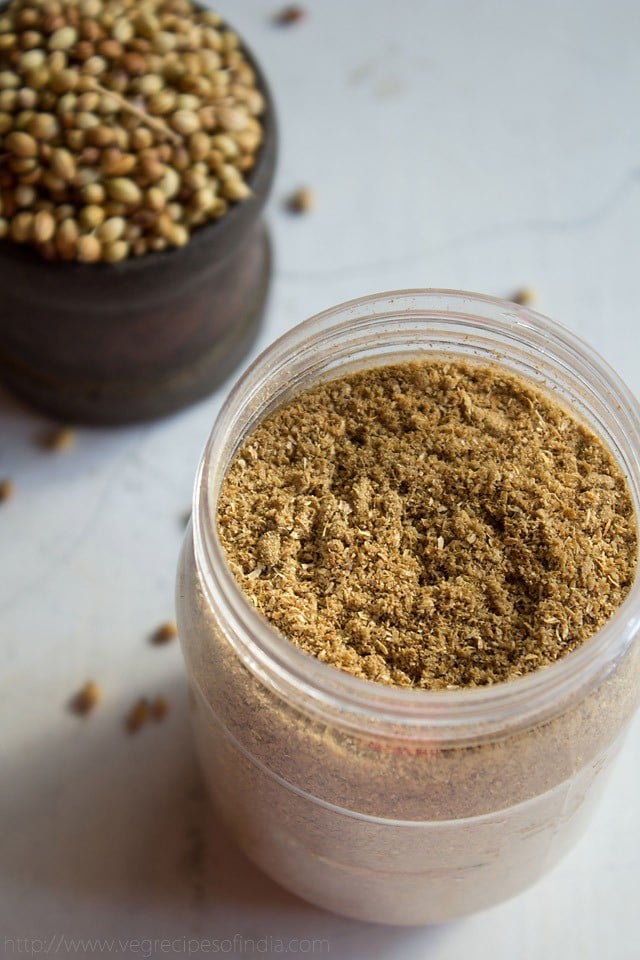
About Coriander
Coriander, also known as dhaniya or dhania in Hindi, is an annual herb that is related to parsley, carrots, and celery.
The plant itself may sometimes be referred to as cilantro (especially in America), though the seeds of the plant are known as coriander.
The entire coriander plant is edible, including leaves, stems, and seeds. The scent of coriander is bright and citrusy, reminiscent of lemons and limes, with a warm, spicy, and citrusy flavor.
Table of Contents
Dhaniya is widely used in many global cuisines – from Indian to Mexican foods, Thai to German, Russian and Central European. And it’s no wonder, either. Coriander is delightful!
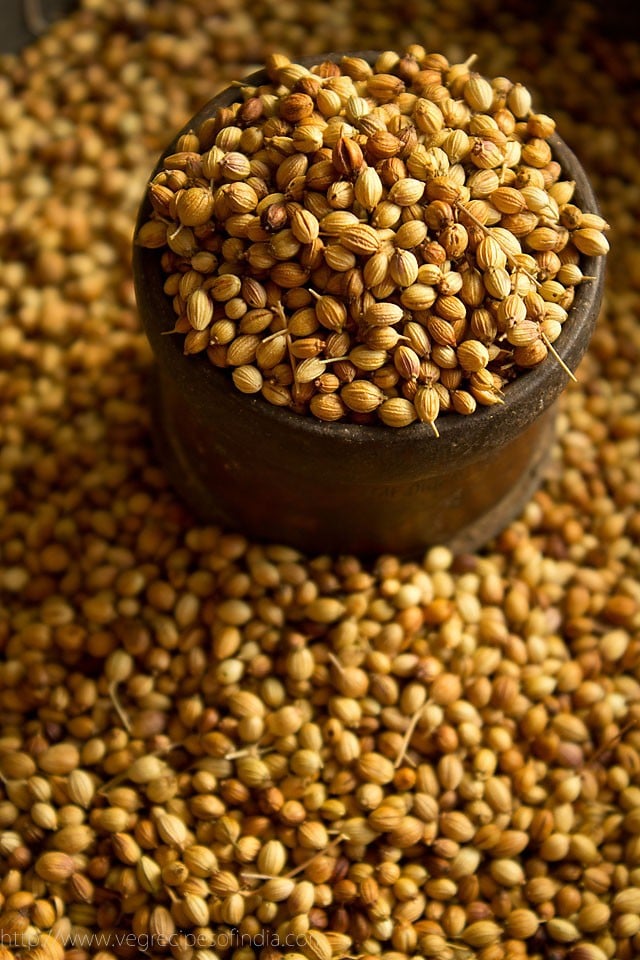
About Coriander Powder
Coriander powder (called dhaniya powder in Hindi) is made from the roasted and ground seeds of the coriander plant. When the plant has passed its productive cycle, it bolts and creates small, round, light brown fruit or seeds.
These seeds are then either dried in the sun for a few days or pan-roasted until fragrant (I have included both methods below). The seeds are then blended in a spice grinder or a dry grinder jar to make coriander powder.
Health Benefits of Coriander
The leaves and stems of coriander have more nutritional power than the seeds, hosting relatively large amounts of vitamins and minerals. That said, the seeds are still a good source of fiber, as well as minerals including calcium, iron, magnesium and manganese.
In addition, coriander seeds have been associated with several positive health outcomes. These include lower blood sugar, improved heart health, reduced anxiety, healthy digestion, and slowed aging of the skin.
Why Make Homemade Spice Mixes?
You may have noticed that I have a fetish for making all things from scratch, and that includes homemade masalas and ground spices, too. If you’re considering jumping on the “from scratch” train, there are lots of reasons to do so:
First, homemade spice powders have a longer shelf life than their store-bought counterparts, which makes lots of sense. Whole spices keep more of their essential oils intact during shipping, meaning you’ll get more of the fragrant and delicious flavor of coriander if you grind it at home.
As a result, I make all of my own spice powders like cumin powder, Garam Masala Powder at home.
On the request of my readers, I have also posted the method of making many homemade spice mixes like:
Second, and perhaps even more importantly, homemade spice powders are unadulterated with fillers.
When I was a kid, my mom would tell me that readymade coriander powder is “supplemented” with horse dung. Turns out, she was right.
While reading on the web, I saw many articles on adulteration and was shocked to read that they add things like sawdust, horse dung to fill the ground spices.
And buyers, beware: it is not only coriander powder that is adulterated but also red chili powder, turmeric, garam masala and other spice powders!
Don’t you think it is so much better and cheaper to make everything from scratch, like this fragrant and delicious coriander powder made from freshly roasted coriander seeds?
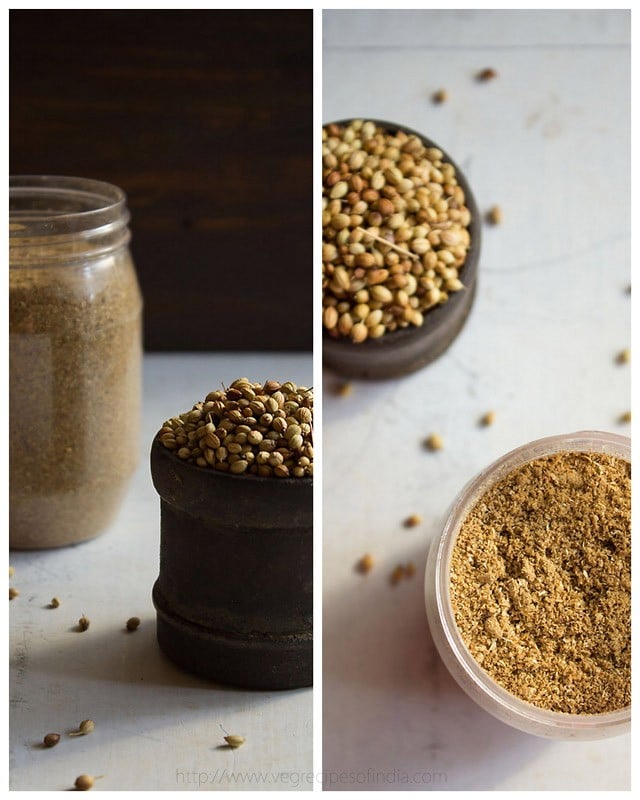
How to Make Coriander Powder (Ground Coriander)
This “recipe” is so simple, you’ll wonder why you ever bothered with getting ground spices from the store in the first place.
Step 1: Prep. Pick through the coriander seeds to get rid of any stones or debris that may be lurking in the bag.
Take the amount you prefer. Small amounts like half to one cup are better. Do not make large quantities as the aroma wanes over a period of time and larger quantities will take many months to be used up.
Step 2, Option 1: Sun Dry. Spread the seeds on a large tray or plate and dry in the sun for 1 to 2 days. While sun-drying, place a splatter lid or a fine mesh lid, or a thin muslin on the plate/tray to keep away the dust.
Step 2, Option 2: Pan Roast. The other method is to roast the coriander seeds in a pan on low heat until they become fragrant, crisp, and with a slight color change. Be careful not to brown or burn them and stir them often while roasting. Cool to room temperature before proceeding.
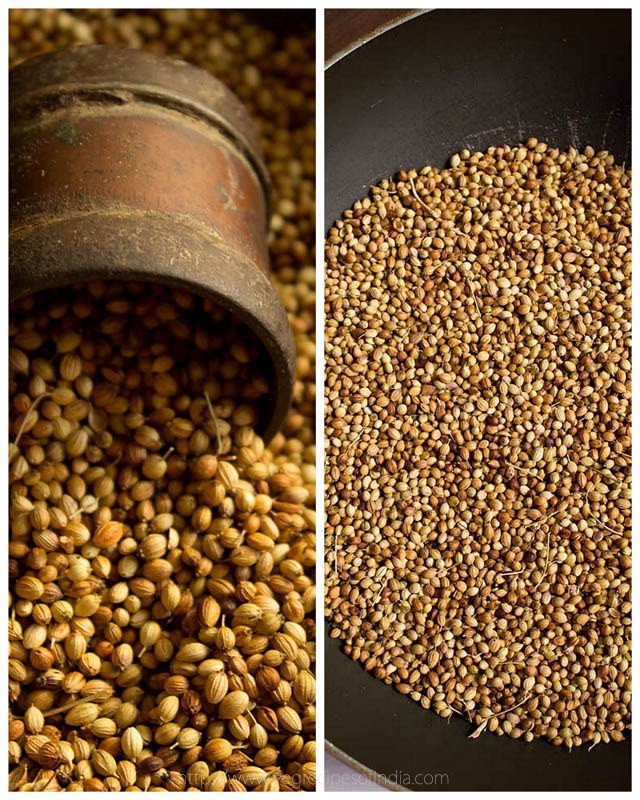
Step 3: Grind. In a spice grinder or a mixer-grinder, make a fine powder of the coriander seeds.
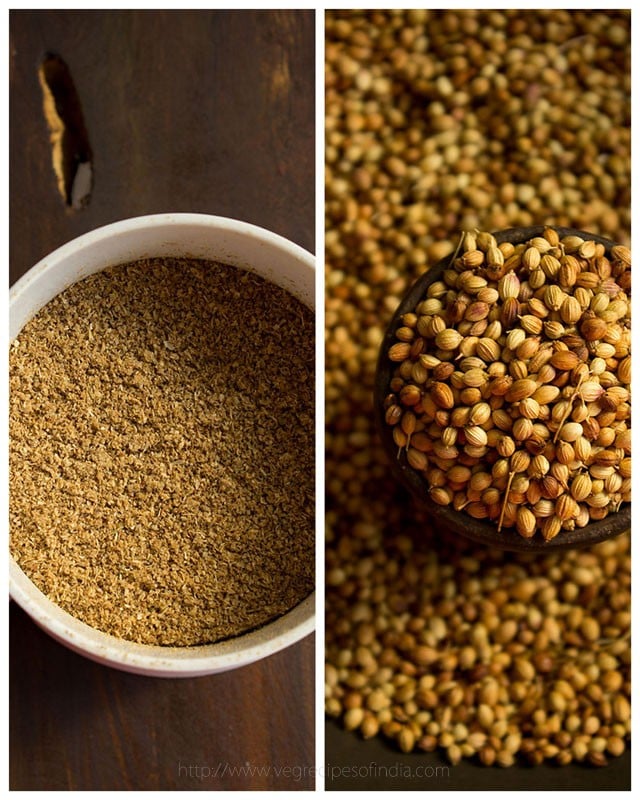
Step 4: Storage. Store coriander powder in a clean and dry airtight container in a dry and cool place or keep the bottle in a fridge. For best results, use within 3 months.
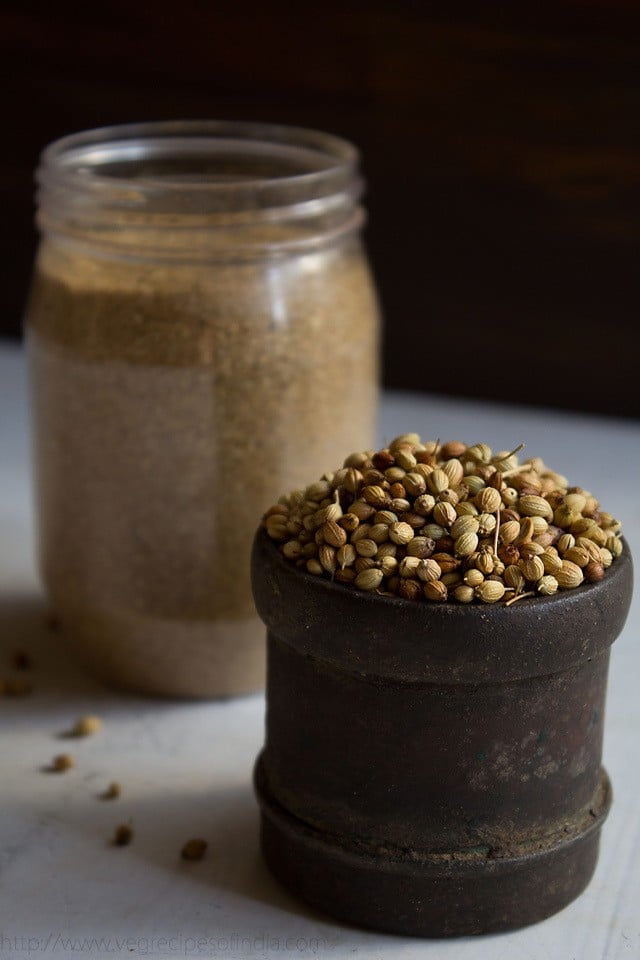
How to Use Ground Coriander
Coriander powder is present in an overwhelming number of recipes on this site. You can use them in many Indian recipes together with cumin powder or garam masala or with a combination of aromatics and spices like onions, garlic, ginger, and green chilies.
Always follow the recipe and use this ground spice as mentioned in the recipe. Do not add a lot of it as the flavor of that dish may get unbalanced.
This, my friends, is just the tip of the ice burg. Go ahead and make this homemade dhaniya powder – I can promise you’ll find LOTS of ways to use it, both on this blog and in many other cuisines!
Tips & Tricks
Making homemade spice powders and masala blends is super easy, but there are two things you should keep in mind:
- Quality: Before you make any spice powder or a spice blend, always buy good quality spices. For making coriander powder, buy fresh coriander seeds of good quality, preferably organic and make sure they are in their shelf period. I don’t know about other countries, but in India one can actually whiff the spices before buying. So go ahead and give those seeds a good whiff before buying! If they smell bright and, well, coriander-y, you know they’re good to go.
- Roasting or Drying Spices: It is always better to roast or sun-dry spices before you make any spice mix with them. Roasting releases the essential oils from the spices and gives a more potent and brighter flavor. While both roasting or sun-drying removes any moisture from the spices and increases their shelf life.
- Storage: Store the coriander powder in an airtight container in a cool and dry place or keep in your refrigerator. It keeps well for about 6 months. Always remove the ground spice with a clean dry spoon and not a wet spoon. If any water goes into the spice mix, there is a chance of fungi or molds developing in it.
FAQs
No! While both cumin and coriander are used with great frequency in Indian cooking, they are not the same. Coriander seeds are light brown and round with a pungent citrusy scent; cumin seeds are long and slender with a light brown color and a warm, earthy scent.
Technically, spices can stay in your cupboard for years without going “bad.” That said, they will lose their aromatic pungency the longer they sit. For the best flavor, I recommend using spices within 3 to 6 months of grinding. This is yet another reason to make your own spices at home! The store-bought stuff might’ve been on the shelf for 6 months before you even bring it home.
Coriander is considered a cooling spice, helping to detoxify the body and remove excess heat. As such, it is a perfect spice to add to your summer beverages!
Popular Indian Recipes Using Coriander Powder
Dal (Lentils) & Legumes
Snacks Recipes
Okra Recipes
Paneer Recipes
Please be sure to rate the recipe in the recipe card or leave a comment below if you have made it. For more vegetarian inspirations, Sign Up for my emails or follow me on Instagram, Youtube, Facebook, Pinterest or Twitter.
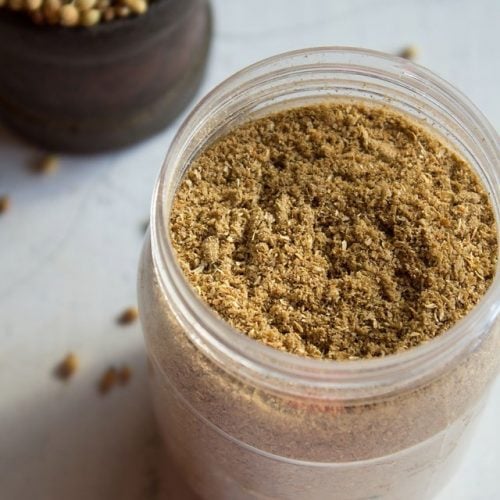
Coriander Powder Recipe (Dhaniya Powder)
Ingredients
- 1 cup coriander seeds (sabut dhaniya) – 80 grams or you can use ½ cup
Instructions
Prep coriander seeds
- Pick the coriander seeds to get rid of stones or any debris.
- Sun-drying method: Spread the seeds on a plate or tray. Cover the coriander seeds with a thin muslin or a splatter lid (lid with a fine mesh). Sun-dry in the sun for 1 to 2 days.
- Pan roasting method: The other method is to roast the coriander seeds in a frying pan or skillet till they become fragrant, crisp and with a slight color change. Stir frequently while roasting.
- Do not brown them or burn them. Transfer them to a plate or tray and cool at room temperature.
Make coriander powder
- Using a spice-grinder or mixer-grinder, make a fine powder of the coriander seeds. Let it cool completely.
- If your spice-grinder is not able to make a fine powder, then sift the coarsely ground powder with a sieve. Add the coarser bits collected on top of the seive back to the spice-grinder and grind again.
Storage and Uses
- Store coriander powder in a clean and dry airtight container in a dry and cool place or keep in the refrigerator. Use as needed in the recipe. This ground spice keeps well for 3 months.
- Always remove the coriander powder with a dry clean spoon. Do not use a wet spoon and make sure that no water goes into the jar. Presence of water or moisture can lead to the growth of mold or fungus in the coriander powder.
Notes
- Quality: Make this homemade coriander powder with fresh coriander seeds within their shelf life. Use the best quality and preferably organic coriander seeds. The seeds should have a good aroma. Make sure they are not infested with insects or mold.
- Note that the approximate nutrition info is for 1 teaspoon of coriander powder.
Nutrition Info (Approximate Values)
Coriander Powder recipe from the archives was originally published on April 2012.
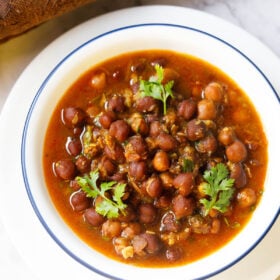
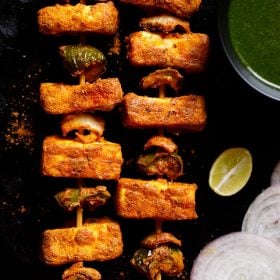
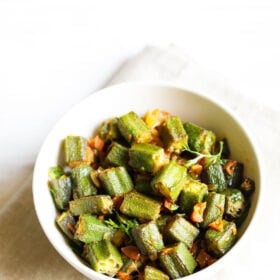

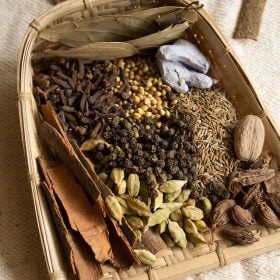
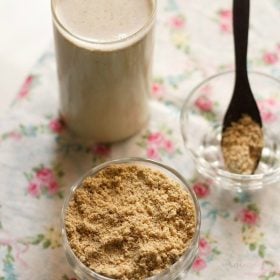
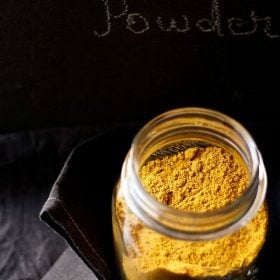
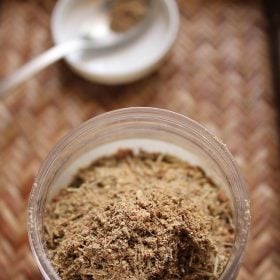








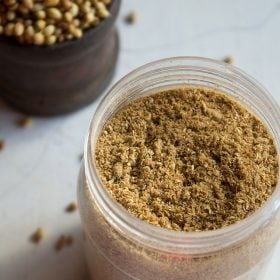
Lovely Recipe. Fresh Homemade coriander powder is always best.
hi
I have home made coriander powder at home since 4 months but I feel whether it is good for consumption as when I opened it the coriander smell was not there. how to know whether it is decayed?
the the freshness becomes less over a period of time for any ground spice. so the aroma becomes less. if it get spoiled, it will become powdery and also sometimes lumpy. insects are also seen. if there is no aroma at all, then i suggest to discard and make a fresh batch.
I want to grind dried termaric at home. Plz tell me how to grind termaric in fine powdered form. If possible , send recipe on email I’d . Thanks!
krishna, i would suggest to give the turmeric to a grinding mill outside. thats what we do. grinding turmeric at home is not easy.
Just like your mother & grand mother I do agree and therefore have learnt from my mother to make all dry masalas at home. Your site was very helpful for me to know that I’m still following the method correctly. Thanks a lot. And bye !
welcome zehra.
hi could you please post the recipe of Garam masala powder specially for Andhra curries
Thx
Chinni
i will be posting a general garam masala recipe soon. i think it can be used for andhra curries. but again andhra style garam masala would be different. so will try to post that too.
Thanks for this….I’m going to try making my own…..thanks a million….:)
thanks carol
Very informative. I’m attempting the same process with my mother-in-law’s (MIL) guidance. Its the first time i’m attempting to powder ‘haldi, mirchi, dhania and garam masala’ at home.
Totally clueless of how to pick up the right quality stuff I went to a local store and bought 1kg of coriander seeds costing Rs.110/-. When I got back my MIL said this is not the right kind as it has a mix of green and white seeds and that it is surely treated with chemicals because green usually means its not dried well and sprayed with lot chemicals to prevent it from catching fungus or it is chemically dyed. According to her if it is packed without drying well it will go bad unless you spray lot of chemicals.
Need your insight on this. How to get good quality stuff – coriander and other spices.
when i buy whole spices, i always buy organic ones. so in a way i am assured that they have not been treated with chemicals etc. and to my surprise the organic ones stay fresh for a long period of time than the market brought ones.
as a guideline when you buy spices, they should smell fragrant. if they are fragrant, they are good and fresh. the coriander seeds should look crisp and not soft. my suggestion would be to buy organic spices.
your method is very good alongwith pictures, till now I m using spices from market but now I will make them in home only.
thanks reena. always make the masala or spice powders at home. they are fresh, aromatic and have a longer shelf-life.
Dear Dassana,
Thanks for teaching a pictorial process of making dania powder at home. If possible, can u pls teach us how to make haldi, chilli and jeera powder at home so that we can stop using those adulterated ready made powder available in the market.
Thanks Sudeshna
thanks sudeshna. actually haldi, chili and jeera powder are easy to make at home. i have made haldi powder at home but did not take pics. have also made chili and jeera powder, but did not take pics. i will keep your request in mind.
This cookery site is marvellous. Every recipe gives marvellous results. Tks a million for all these wonderful recipes and goes without saying the pictures as well.
thanks deepa for the encouraging comments.
hi dassana
your post was a saver, i slighthy browned the the seeds,cooled and grinded it, oh waht a aroma in my kitchen
thanks dassana
thanks sunita.
Hey Dassana, even I make the coriander powder at home, I roast the coriander light brown and then after cooling grind them but not to smooth powder, coarsely grounded powder coz that’s how my in-laws prepare it but my mum uses your method of fine powder.
Really loved your clicks, so very natural:)!
Homemade powders are always more flavourful and aromatic….beautiful pics!!
yes sharmilee, they are…
I love the pics, they actually took me back to those old days when Mom made this the dhania powder at home. She also made a certain Chilli powder mix , along with dhania powder and haram masala in place of just the plain Red Chilli powder.
Shocked to hear about the stuff used for adulteration!